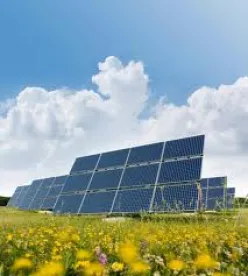Time may be running out for large scale photovoltaic and other solar electric generating projects due to a looming statutory reduction in the federal investment tax for such projects (the ITC). The ITC is the primary federal tax subsidiary for solar electric generating projects. For solar electric generation projects that are “placed in service” before Jan. 1, 2017, the ITC is 30 percent of the eligible tax basis of the project. For solar electric generation projects placed in service on or after Jan. 1, 2017, the ITC drops to 10 percent of the eligible tax basis.
Many solar electric generating projects will be economically unviable at the reduced ITC rate. Large scale solar electric generating projects (20MW or greater) can easily take up to two years to design, permit and construct. Thus, a large scale solar project just going into development today will be hard pressed to make the Dec. 31, 2016 placed in service deadline. If there is any significant risk that the project could miss this deadline, the project developer may cancel the project entirely. Case in point is the recently cancelled 500 MW Palen Solar Project that was to be located in Riverside County, California. The developers of that project cited the potential inability to place the project in service by the Dec. 31, 2016 deadline as one of the reasons for the cancellation of the project.
To make matters worse, there is no bright line test to determine precisely when a solar project has been “placed in service” for ITC purposes. Instead, the IRS (and ultimately the Courts) apply a subjective facts-and-circumstances analysis, which considers the following factors to determine whether a solar project has been placed in service for ITC purposes: (i) receipt of required licenses and permits to operate the project; (ii) passage of control of the project to the owner from the construction contractor, (iii) completion of critical tests, (iv) connection of the project to the local electric grid, and (v) most importantly, the ability to generate and sell electricity in commercial quantities (even if not at the project’s rated capacity). This lack of a bright line “placed in service” test puts further pressure on the developer to make certain the solar project is operating well in advance of the Dec. 31, 2016 deadline.
The primary federal tax subsidy for wind and hydroelectric generating projects is the Production Tax Credit (PTC), which was allowed to expire except for projects for which “construction commenced” prior to Jan. 1, 2014. By definition, the “commenced construction” requirement is significantly easier to meet than the “placed in service requirement.” In addition, the IRS has provided bright line guidance to determine whether construction of a project has commenced for PTC purposes. The solar electric industry has lobbied to replace the Dec. 31, 2016 “placed in service” deadline with a “commenced construction” deadline, and there has been some support for this proposal in both the House and Senate. Under this proposal, if passed, a solar project could qualify for the 30 percent ITC even if the project is not placed in service by Dec. 31, 2016, so long as construction of the project commenced before then. This would provide welcome breathing room for proposed large scale solar projects currently on the drawing board. Unfortunately, passage of this proposal is far from certain.
In light of the uncertainty of an extension or modification of the Dec. 31, 2016 placed in service deadline for 30 percent ITCs, developers of new large scale solar projects will need to move quickly to make certain the projects satisfy the subjective “placed in service” rules well before then.



 />i
/>i
